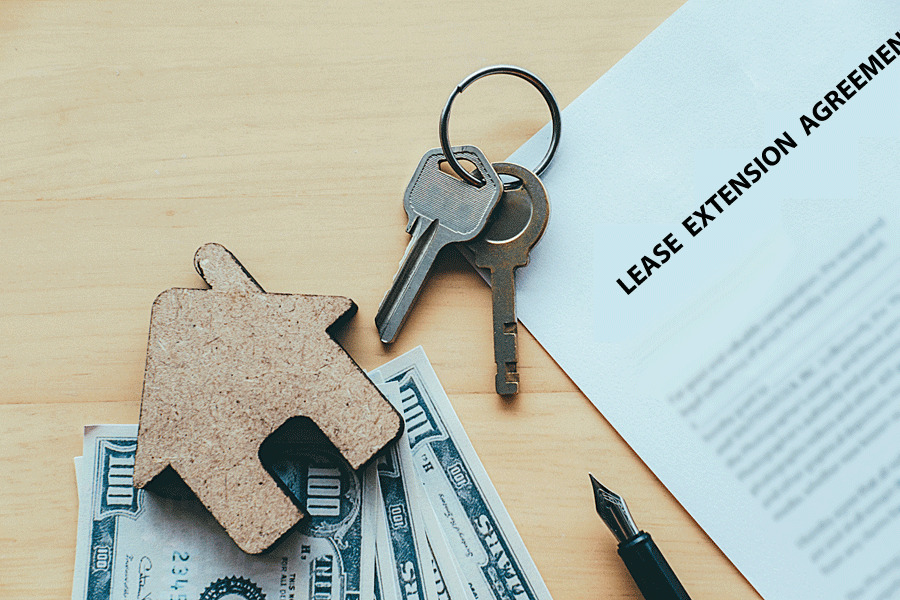A Month-to-Month Rental Agreement is a legal rental contract between a property owner and a tenant outlining their formal relationship monthly for an unspecified period.
A month-to-month rental is just like a standard agreement in terms of moving-in, eviction laws, housing laws, and obeying local ordinances (all rights under landlord-tenant laws.). The only notable difference is that the landlord and the tenant can cancel the agreement at any time so long as they have submitted a Notice to Quit (Lease Termination Letter). The state notice period, usually 30 days, determines the number of days before termination of notice should be sent. Rent increase may also be changed with a 30day notice.
note
This agreement differs from a long-term residential lease agreement which lasts for at least one year
Free Standard Month-to-Month Rental Agreement Templates
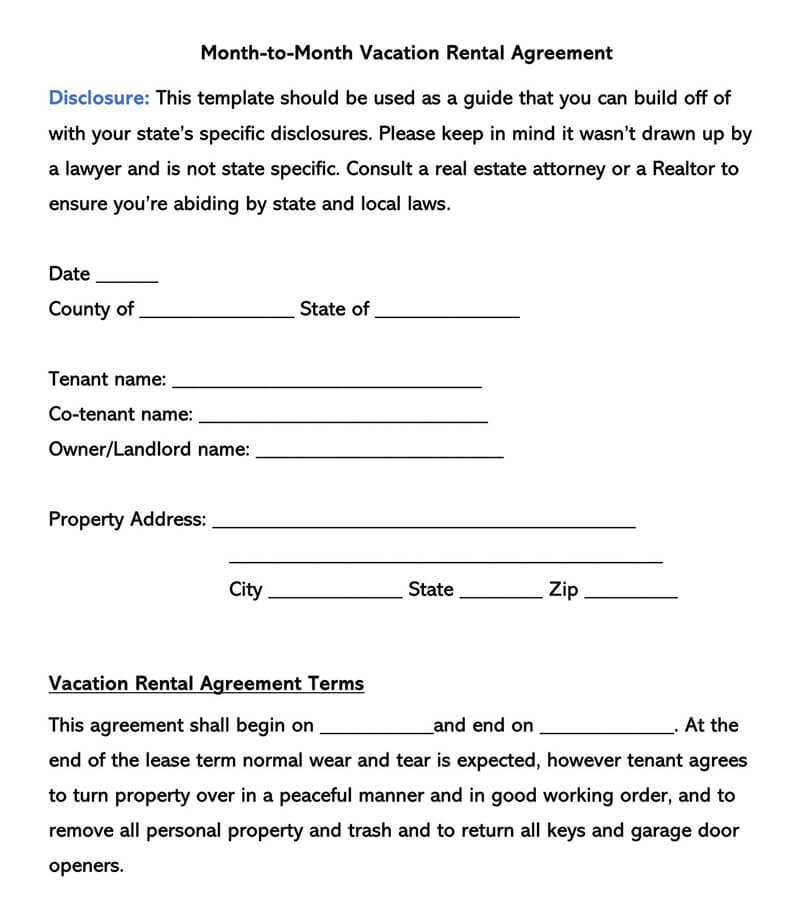

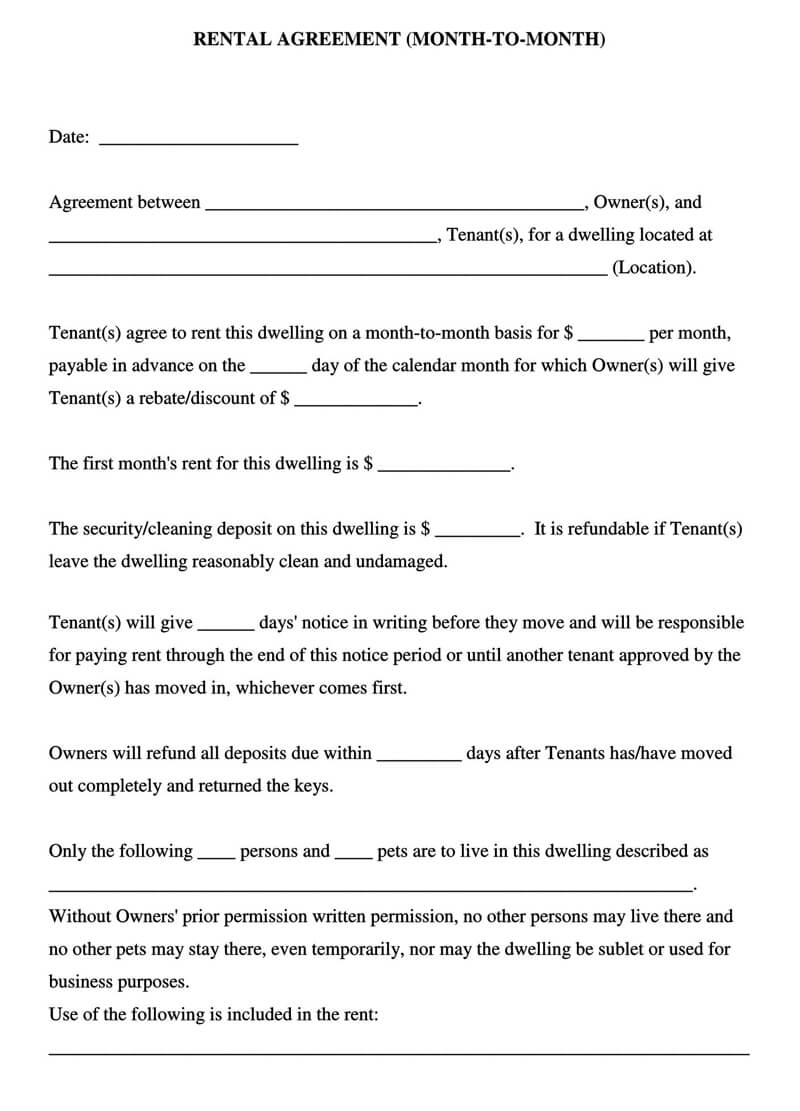
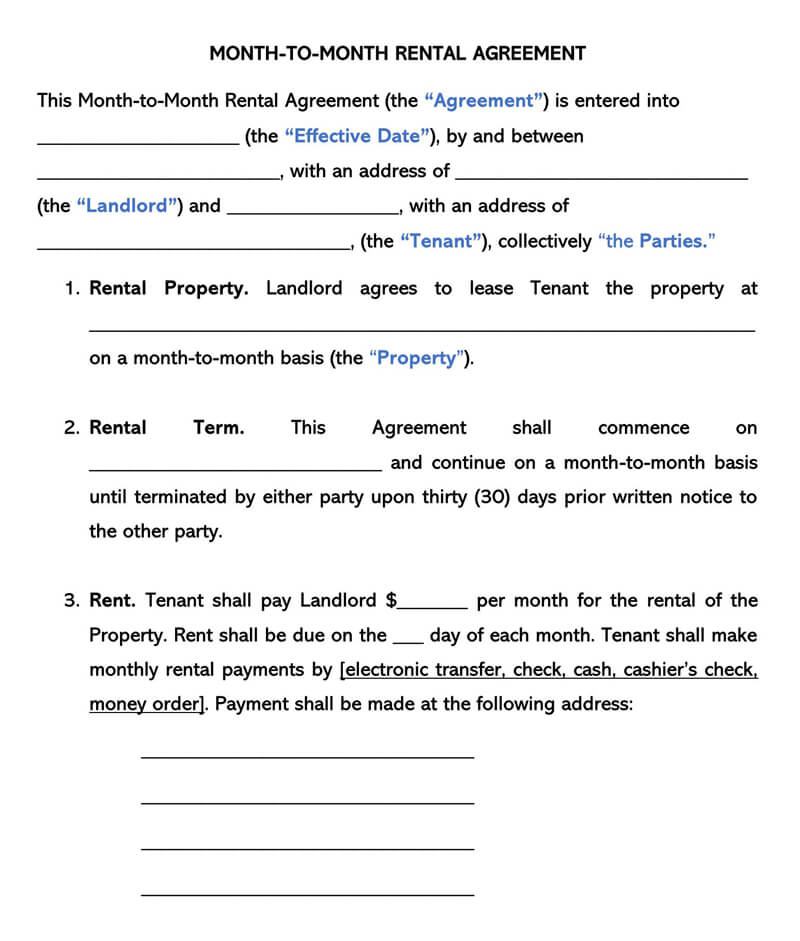
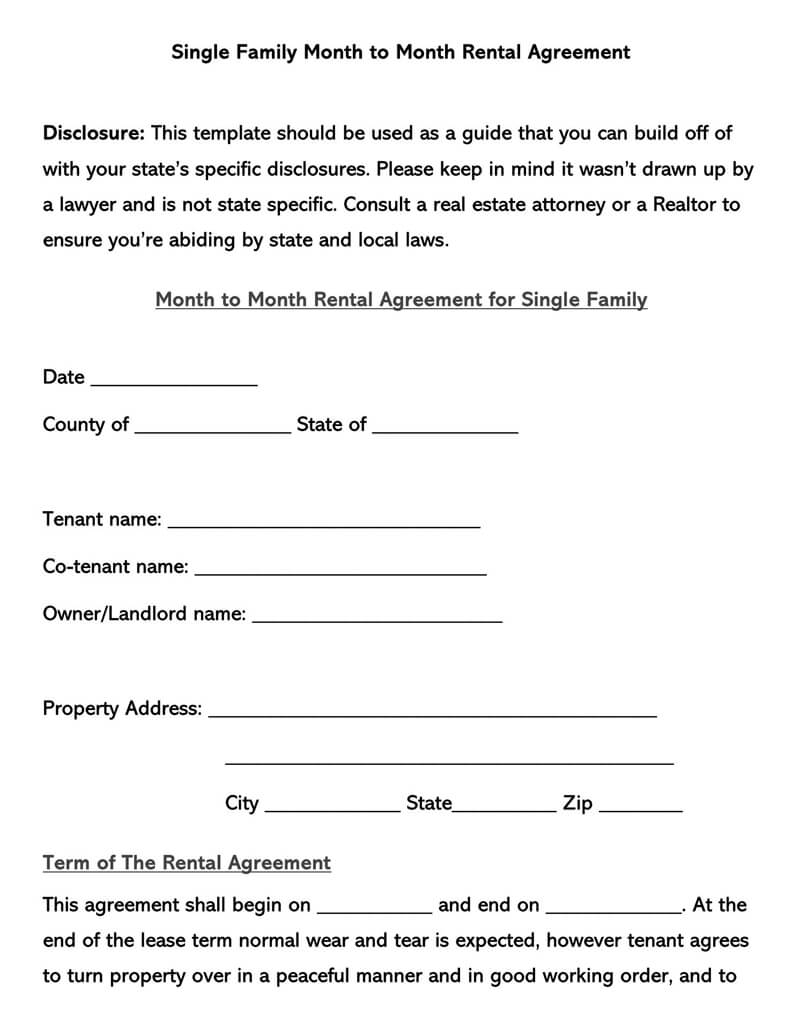
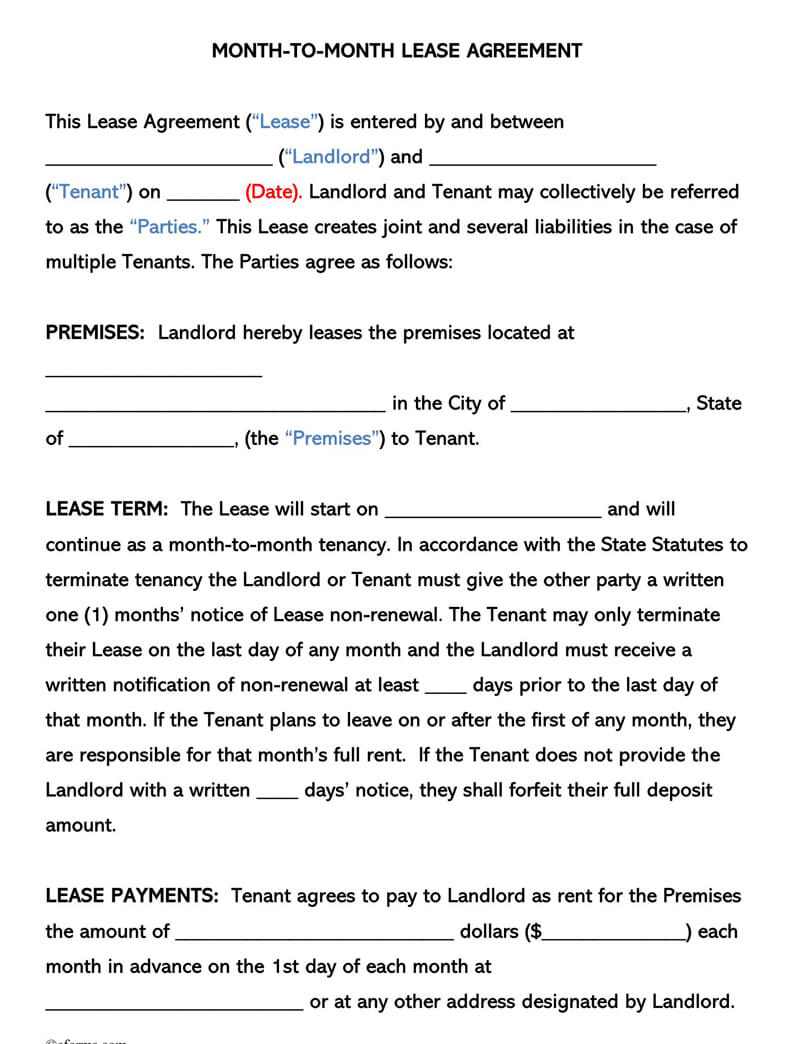
Types of Month-to-Month Rental Agreements
There are three different types of month-to-month rental agreements that can help meet the needs of tenants. The three types of leases include:
- Commercial Lease: A commercial month-to-month lease is a rental contract used in commercial property between the property owner or landlord and a business tenant in need of the space without committing to more than 30 days. It is also known as a ‘monthly lease.’
Commercial property has no minimum termination period meaning that a landlord or tenant can make a required termination less than 30 days in a commercial lease. - Residential Month-to-Month Lease (comprehensive): A comprehensive month-to-month lease is strictly a rental property lease between the tenant and the landlord based on the month-to-month agreement. This type of residential lease is very detailed in the information it seeks from a tenant.
- Residential Month-to-Month Lease (simple): A simple residential month-to-month lease is similar in its definition to a comprehensive lease. The only difference being the information sought in it is not as detailed and is simply spelled out on the contract.
Suitability of Agreement
Owning property intended for rent or leasing as a tenant is a big responsibility regardless of its use. Therefore, both the landlord and the tenant must individually ask whether it is suitable for them.
Considerations should be made:
For landlord
The desire to have the perfect tenant who makes timely payments and is easy to communicate with is always in the back of a landlord’s mind. Finding a suitable tenant for a property can be challenging, which is why most landlords prefer entering ‘trial periods’ before offering a long-term lease.
Suppose a landlord finds that the tenant is not a good fit for them for whatever reason, they can end the lease by issuing a lease termination notice in which the number of days the tenant has to move out may vary by state.
The month-to-month rental agreement does not bind the landlord by the terms of an annual lease, giving them the liberty to leave the property management business if they wish to.
With a month-to-month rental agreement, it is easy to adapt to the changing housing market. A landlord can make a rental increase through the issuance of a notice of rent increase. This ensures the profitability of rental property is realised at a faster rate than fixed term.
For tenant
Property ownership can take a long time, depending on an individual’s financial situation. The ability to rent a space for work or living is more manageable and provides a tenant with the option to walk away.
With the month-to-month rental agreement having an automatic renewal at the beginning of each month, making it perfect for tenants who:
- wish for less restrictive housing,
- are trying out rental before making a long-term commitment,
- are into a minimalistic lifestyle as rentals often come fully furnished,
- and are college students or transient workers in town for a couple of days.
When the tenant desires to break the lease, issuing the landlord a notice of intent to vacate terminates it by the end of the month. However, when a tenant feels happy in their rental or is in good relations with the landlord, they may freely and quickly transition into a fixed-term lease.
How Month-to-Month Lease Works
For a month-to-month lease to be effective, the tenant and landlord must engage in a step-by-step process. The process is critical to ensure that the parties are the right fit for one another.
It includes:
Invitation to lease
The first and foremost step should be to invite prospective tenants to enter the rental agreement. This information is disseminated through the local dailies, property rental sites, and other avenues that deal with real estate.
Application process
Upon receiving the applications from far and wide, one has to go ahead to screen the applicants. This entails checking their criminal background, creditworthiness, behavioral traits, and any issue of common interest.
The process of acquiring a month-to-month lease requires tenants to provide information concerning their lives. The landlord determines the depth of the information. In most cases, the landlord’s interest is to ensure that the tenant can meet rent payment obligations; thus, a simple credit and employment check will be enough.
The following resources might help:
- VerticalRent.com (for free limited background checks)
- MySmartMove.com (detailed background checks for $25)
- Employment (Income) Verification
Show the tenant the property
From the very start, the goal of a landlord with any vacant space is to arouse the interest of a potential tenant. To achieve this, a landlord or hired agent will show the space or property to any interested party. An interested tenant ensures that they fully evaluate the space by inspecting all fixtures and appliances in the property.
A landlord or agent should ensure that they leave no stone unturned. Showcasing parking space, common areas, entry and exit ways, and any other amenities keeping in mind that they never know what will catch a tenant’s interest.
Once the landlord or agent identifies an interested party, it is crucial to obtain their personal information through the rental application or obtain formal communication contacts such as an email for further personal information later.
Making the decision
A landlord may receive several applications on the rental property; thus, they can create specific criteria to protect themselves and help in the elimination process. The criteria made can be against lousy credit, security deposits for tenants with no renting history, pre-paid rent, and direct bank monthly payment
Approval by the landlord is followed up by lease negotiations, while a rejection requires them to provide reasons by sending a rejection letter.
Draft the rental agreement
The drafting process begins with the negotiation of terms between the tenant and the landlord. Ensuring that as many items of concern on either side are discussed is very important.
Some of the basic items include:
- The location of the premises: When drafting the month-to-month lease agreement, the property’s location must be included to ensure that the rental is subjected to the appropriate state laws.
- The landlord’s name: Including the Landlord’s name in the draft of the month-to-month lease agreement critically helps identify them as the lessor of the property up for rent.
- The tenant’s name must be included in the month-to-month rental agreement to identify them as lessee of the property up for rent.
- Monthly rent ($): When drafting a month-to-month lease agreement, the inclusion of the monthly rent will inform the tenant of expected payments at the end of each month.
- Security despite: Including a security deposit in the rental agreement insures the property in case of damage. However, the amount payable must be within the state maximum limit to meet the legal standard.
- Termination period: The landlord must include the termination period he or she negotiated with the tenant to ensure compliance with the state’s month-to-month termination laws.
- Pet: The landlord must include any payment for having pets on the property in the month-to-month rental agreement. This will ensure any property damage caused by the animal.
- Parking: The landlord should include parking space availability or the lack of it in the month-to-month lease agreement. This will help the tenant decide if they should find a parking area near the property or inform them of any payments they are expected to make to ensure they have a designated parking space.
Apart from that, other elements of the lease are comprehensively discussed in the next section of the article.
Disclosures
The tenant must ensure that all the necessary documents attached to their lease, like the State addendums, are there. A state addendum is an attachment contract that modifies the original contract’s terms and conditions and varies from state to state.
The two standard disclosures are:
- Lead-Based Paint Disclosure: According to federal law, the Residential Lead-Based Paint Hazard Reduction Act of 42 U.S. Code § 4852d must be provided by the landlord or lessor to the tenant moving into properties built in 1978.
- Move-in Checklist (Inspection): The move-in checklist disclosure requires completion at the beginning and end of the month-to-month lease term. It is ensuring that disagreements on the security deposit are dealt with.
Execute
When the documentation is in order, and both parties are satisfied by the review of the agreement with no further query, then the lease can be executed. Execution of a lease takes place by involving a third party as a witness. Unless the monthly rent is expensive, there is no need for the notary public.
During the execution of the month-to-month rental agreement, the landlord and tenant are required to bring:
Things the tenant should be requested to bring
The tenant is responsible for bringing the following:
- First month’s rent
- Security Deposit.
- Rent proportion amount- This is if they have decided to move in before the first (1st) month.
- Park fees (if any)
- Pet fees (if any)
- Pre-paid Rent (if any)
Things the landlord should bring
The landlord is responsible for:
- Providing access (keys) to the property, common areas, parking, mailbox, etc.
- Obtaining a copy of the executed lease
Moving in
Security deposit made and the month-to-month rental agreement signed; all that is left is for the tenant to take residence in the property. If a time comes when either the landlord or tenant decides to cancel the agreement or rather opt-out, a Notice to Terminate must be sent via certified mail, and a return receipt must be received per their state laws. The return receipt will serve as evidence that the notice was sent.
Writing the Rental Agreement
The rental agreement contains detailed information divided and subdivided even further to ensure that its contents are clear and concise. A written month–to–month rental agreement contains within it the:
Month-to-month rental declaration
To write the month-to-month rental agreement, both the landlord and the tenant must start with a declaration. The declaration includes:
- Landlord: The landlord’s full name should be documented in the declaration at the beginning of this agreement.
- Tenant: The full name of the tenant. Whether he/she decides to enter the lease as an individual or along with a family member, spouse, or friend, the complete names of all involved tenants are essential for the document.
- Date: It is recommended that the intended effective date is used. This means the date on which the tenant intends on moving in.
Premises
The location of the premises should be indicated in this section of the month-to-month rental agreement. The information needed in this section of the lease includes:
- Street Address Location: The street address may include the building number, street or road, and unit number if needed for access. This helps to identify the property under lease.
- City: The city refers to which location the property is in. It will ensure that even in instances where specific rental properties contain similar names to others, the city stated will set them apart
- State: The state’s name must also be indicated to ensure that the lease falls under the laws of that state and meets its requirements for maximum effectiveness.
Lease term
The lease must contain critical information which will stipulate its terms. This information includes:
- Start Date: Establishes the first effective calendar date that the tenant can reside in the rental property for rent payment.
- Required Termination Notice: The month-to-month lease offers flexible termination for both parties. The landlord and tenant are required to highlight the number of days before the month ends that a notice must have been sent. These days must be expected but also fall in alignment with the relevant state jurisdiction.
- Verify Notice Time Frame: The lease should document that termination may only occur on the first of the month, provided there are no violations. The tenant should indicate to the landlord on the contract the number of days before the first of the month, informing them of their desire to terminate.
Lease payments
The rental agreement must within it contain information about payment the tenant will be expected to make. This information may include:
- Monthly Rent Amount: The tenant’s monthly amount of money will be expected to pay, which must be contained in the document.
- Due Date: The due date should be indicated in two digits, such as 01,12, 29, etc. It states the day the landlord expects to receive the rent payment.
- Late Charges: These are any additional daily charges that a tenant may incur if any amount or the total amount is not paid within a specified period. This part of the document also gives an ultimatum when full payment is not made on time.
Penalty payment
The lease payment must state any money the tenant must pay should they violate the agreement. The penalty payment slot must include:
- Penalty Amount: Suppose the tenant makes no payment within the grace period provided from the due date, the landlord may charge a penalty amount that is to be included in the document.
- Default Due to Nonpayment: Unpaid rent for a significant period may indicate a tenant’s inability to meet their obligation. The landlord assumes an intent to make rent payment upon the arrival of the final date on the calendar, which is documented in the lease. Further action may be sought if the landlord concludes that the tenant has no intention of rent payment upon passing the final date on the calendar.
Insufficient funds
A part of the lease agreement seeks to ensure conditions in case of violation concerning fund sufficiency. In it, the following information is to be included:
- Bounced Check Penalty: The slot involves instances when a tenant submits a check that the issuing bank refuses. Penalties such as deposit penalty may be charged. If the tenant submits such a check with insufficient funds, the landlord may ask for a penalty amount to be paid. The amount to be paid is documented in this agreement.
Security deposit
A slot on the lease that makes provision for information relating to the payment of a security deposit. The information includes:
- Deposit Amount: The security deposit acts as an insurance policy for the landlord to hold on to in case of any damage to property or accident during the tenant’s stay. When a lease ends without any property damage, the landlord is expected to return the amount stated in their state set timeline. The collected amount must be documented before signing and meeting the state’s statutes that the property is located.
Defaults
An allotted slot in case a tenant defaults on the payment set on the lease. The information contained within it includes:
- Default Period: Suppose a tenant violates any of the contents of the lease and he/she decides to continue their residency in the premises. The landlord is obliged to pursue any action necessary to collect the money owed. However, local jurisdiction often requires the landlord to give the tenant a notice of their status. The number of days the landlord expects to wait for the response should be included in the lease.
Occupants
A slot on the lease providing information on the occupancy of the property. The information that must be contained within it includes:
- Occupants on Property: The rental agreement must contain the maximum number of occupants the landlord will allow to live on the property without requiring their approval for the duration of the lease.
Assignment and sublease
The landlord may allow the tenant to sublease the property to a third party. This slot contains information on:
- Sublet Option: The option on the lease will indicate whether a tenant can lease the property to a third party, acting as the property’s landlord in a separate agreement with a subtenant. The landlord must approve any subleasing agreement by the tenant.
Utilities and services
The amenities the tenant is expected to use during their residence in the property. The lease must contain information on:
- Landlord Responsibilities: The lease must contain a default list of financial responsibilities to be met by the landlord. Utilities and services paid for the property’s maintenance in the duration of the lease are to be stated. The landlord must check off each item they will be responsible for.
- Additional Utility Obligations: Any utility or service the landlord is responsible for that is not on the list requires that an area of the report is provided for it to be taken into account. The tenant will be expected to take responsibility for any unchecked or unselected utility for the duration of the agreement.
Pets
Suppose the tenant owns any pets or plans to have a pet during their residence. This slot will provide information involving:
- Pet Deposit: Keeping a pet without informing the landlord is generally not acceptable. The rental agreement provides for the demand of a pet security deposit if the animal damages any property. This deposit is assumed before the pet is allowed on the property, with the amount indicated regardless of whether the tenant states whether or not they will have it.
Abandonment
Property is considered abandoned when it is left unoccupied after a significant period. This slot contains information on how and when it is to be considered by the landlord.
It includes:
- Tenant Abandonment: A property left unoccupied for an extended period may be deemed abandoned. The minimum period in which a property is deemed abandoned is stated in the lease as agreed with the tenant.
- Rent Abandonment: The landlord must provide the minimum number of days the property can remain in the care of an absentee tenant with unpaid rent before their lease is terminated.
Governing law
Different states have their legislative laws concerning month-to-month rental agreements. Naming the state on the lease agreement ensures that state laws can be enforced when needed and that the document falls under the jurisdiction of the state’s courts.
Display of signs
The slot involves information concerning when a landlord is expected to place a vacant sign on the plot as agreed with the tenant. It involves:
- Landlord Advertising: With a tenant’s lease coming to an end, the landlord may decide to sign on the property to attract a new tenant. Concerns over the invasion of privacy may be curbed by documenting the number of days before the termination of a lease when the landlord may erect a sign.
Noise
The landlord should ensure that the month-to-month rental agreement stipulates any noise restrictions he/she may have to help protect other tenants that may reside in the property from unreasonable noise levels. When writing this section of a month-to-month lease agreement, the landlord should also include:
- Furniture Delivery and Removal: The allotted slot on the document states the time or day a tenant may deliver furniture to space or property along with the time and day they may remove their property upon termination of the lease.
Parking
Information on any available parking spots on the property, along with the terms set by the landlord, will best on this slot. It includes:
- Parking Accessibility: The lease also indicates whether a tenant has been granted parking space on the property or not.
- Available Parking: Suppose parking space is availed, the tenant must be made aware of the lease of its location on the property and the number of vehicles they are allowed to park.
Balconies
The landlord must approve the use of the balcony for reasons such as storing items and cleaning fabrics like clothes or rugs in this slot by selecting the checkboxes provided in the lease.
Additional terms and conditions
Involves information concerning any further conditions set that includes both parties that they may have agreed on along with the final signatures on the document. The information need in it includes:
- Agreement Provisions: Any additional agreements made between the tenant and the landlord may be stated on the agreement slot of the document. All provisions must be reported along with any aptly titled attachment.
- Signature: Once the lease is completed, a signature from the landlord is all that’s left to place it in effect.
- Printed Name: The name of the landlord is then printed underneath his or her signature.
- Signatures and notarization: Upon review of the written document, the tenant should sign as an indication of their commitment to comply with the described conditions. The signature of a third party witnessing the agreement is also essential.
- Printed Name: The tenant is then also required to print their name on the contract.
Month-to-Month Lease Termination Laws
Different states have their custom laws on the content of the month-to-month lease and different minimum termination periods. A landlord and a tenant must ensure that they check the laws of their state meets legal requirements.
Below is a breakdown of the state minimum termination periods and the laws:
| STATE | MINIMUM TERMINATION PERIOD | LAW |
| Alabama | 30 days | § 35-9A-441 |
| Alaska | 30 days | § 34.03.290(b) |
| Arizona | 30 days | § 33-1375 |
| Arkansas | 30 days | § 18-17-704 |
| California | Time dependent on tenancy | § 1946 |
| Colorado | Time dependent on tenancy | § 13-40-107 |
| Connecticut | 3 days | § 47a-23 |
| Delaware | 60 days | Title 25 § 5106 |
| Florida | 15 days | § 83.57 |
| Georgia | 30 days | § 44-7-7 |
| Hawaii | From landlord 45 days’ notice ,28 from tenant | § 521-71 |
| Idaho | 30 days | § 55-208 |
| Illinois | 30 days | 735 ILCS 5/9-207 |
| Indiana | 30 days | § 32-31-1-1 |
| Iowa | 30 days | § 562A.34 |
| Kansas | 30 days | § 58-2570 |
| Kentucky | 30 days | § 383.695 |
| Louisiana | 10 days | CC 2728 |
| Maine | 30 days | Title 14 § 6002 |
| Maryland | 30 days | § 8-402 |
| Massachusetts | 30 days | § 186-15B |
| Michigan | 30 days | § 554.134 |
| Minnesota | 30 days | § 504B.135 |
| Mississippi | 30 days | § 89-8-19 |
| Missouri | 30 days | § 441.060 |
| Montana | 30 days | § 70-24-441 |
| Nebraska | 30 days | § 76-1437(2) |
| Nevada | 30 days | NRS 40.251 |
| New Hampshire | 30 days | § 540:11(2) |
| New Jersey | 30 days | § 2A:18-56 |
| New Mexico | 30 days | § 47-8-37 |
| New York | 30 days | § 232-b |
| North Carolina | 7 days | § 42-14 |
| North Dakota | 30 days | § 47-16-07.2 |
| Ohio | 30 days | § 5321.17 |
| Oklahoma | 30 days | § 41-111 |
| Oregon | 30 days | § 91.070 |
| Pennsylvania | 15 days of tenancy 1 year or less,30 days of tenancy for more than one year | § 250.501 |
| Rhode Island | 30 days | § 34-18-37 |
| South Carolina | 30 days | § 27-40-770 |
| South Dakota | The landlord gives 30day notice; the tenant must give15 day notice | § 43-32-13 |
| Tennessee | 30 days | § 66-28-512 |
| Texas | 30 days | § 91.001 |
| Utah | 15 days | § 78B-6-802 |
| Vermont | Over 2-year tenancy 60 days, less than 2-year tenancy 30 days | § 4467 |
| Virginia | 30 days | § 55.1-1253(A) |
| Washington | 20 days | § 59.18.200 |
| Washington D.C. | 30 days | § 42–3505.54(a) |
| West Virginia | 30 days | § 37-6-5 |
| Wisconsin | 28 days | § 704.19 |
| Wyoming | No minimum | No statute |
Conclusion
Month- to- month rental agreement is a flexible monthly rental contract between a tenant and a landlord. The laws governing this agreement may vary from state to state, along with the minimum termination period. The landlord and tenant must always remain fully aware of the processes necessary to make this agreement possible. This will ensure the protection of both parties by setting up clear terms and conditions that must be adhered to.





